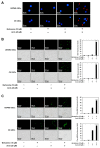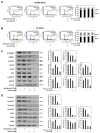Synergistic Anticancer Effect of a Combination of Berbamine and Arcyriaflavin A against Glioblastoma Stem-like Cells
- PMID: 36432068
- PMCID: PMC9699626
- DOI: 10.3390/molecules27227968
Synergistic Anticancer Effect of a Combination of Berbamine and Arcyriaflavin A against Glioblastoma Stem-like Cells
Abstract
Glioblastoma multiforme (GBM) is the most aggressive form of brain tumor. Relapse is frequent and rapid due to glioblastoma stem-like cells (GSCs) that induce tumor initiation, drug resistance, high cancer invasion, immune evasion, and recurrence. Therefore, suppression of GSCs is a powerful therapeutic approach for GBM treatment. Natural compounds berbamine and arcyriaflavin A (ArcA) are known to possess anticancer activity by targeting calcium/calmodulin-dependent protein kinase II gamma (CaMKIIγ) and cyclin-dependent kinase 4 (CDK4), respectively. In this study, we evaluated the effects of concurrent treatment with both compounds on GSCs. Combined treatment with berbamine and ArcA synergistically inhibited cell viability and tumorsphere formation in U87MG- and C6-drived GSCs. Furthermore, simultaneous administration of both compounds potently inhibited tumor growth in a U87MG GSC-grafted chick embryo chorioallantoic membrane (CAM) model. Notably, the synergistic anticancer effect of berbamine and ArcA on GSC growth is associated with the promotion of reactive oxygen species (ROS)- and calcium-dependent apoptosis via strong activation of the p53-mediated caspase cascade. Moreover, co-treatment with both compounds significantly reduced the expression levels of key GSC markers, including CD133, integrin α6, aldehyde dehydrogenase 1A1 (ALDH1A1), Nanog, Sox2, and Oct4. The combined effect of berbamine and ArcA on GSC growth also resulted in downregulation of cell cycle regulatory proteins, such as cyclins and CDKs, by potent inactivation of the CaMKIIγ-mediated STAT3/AKT/ERK1/2 signaling pathway. In addition, a genetic knockdown study using small interfering RNAs (siRNAs) targeting either CaMKIIγ or CDK4 demonstrated that the synergistic anticancer effect of the two compounds on GSCs resulted from dual inhibition of CaMKIIγ and CDK4. Collectively, our findings suggest that a novel combination therapy involving berbamine and ArcA could effectively eradicate GSCs.
Keywords: arcyriaflavin A; berbamine; calcium/calmodulin-dependent protein kinase II gamma; cyclin-dependent kinase 4; glioblastoma stem-like cells.
Conflict of interest statement
The authors declare no conflict of interest.
Figures







Similar articles
-
Inhibition of PRMT1 Suppresses the Growth of U87MG-Derived Glioblastoma Stem Cells by Blocking the STAT3 Signaling Pathway.Int J Mol Sci. 2024 Mar 3;25(5):2950. doi: 10.3390/ijms25052950. Int J Mol Sci. 2024. PMID: 38474197 Free PMC article.
-
A curcumin derivative hydrazinobenzoylcurcumin suppresses stem-like features of glioblastoma cells by targeting Ca2+ /calmodulin-dependent protein kinase II.J Cell Biochem. 2019 Apr;120(4):6741-6752. doi: 10.1002/jcb.27972. Epub 2018 Nov 2. J Cell Biochem. 2019. PMID: 30390339
-
Discovery of a New CaMKII-Targeted Synthetic Lethal Therapy against Glioblastoma Stem-like Cells.Cancers (Basel). 2022 Mar 4;14(5):1315. doi: 10.3390/cancers14051315. Cancers (Basel). 2022. PMID: 35267623 Free PMC article.
-
Antiangiogenic and antitumor potential of berbamine, a natural CaMKIIγ inhibitor, against glioblastoma.Biochem Biophys Res Commun. 2021 Aug 20;566:129-134. doi: 10.1016/j.bbrc.2021.06.025. Epub 2021 Jun 11. Biochem Biophys Res Commun. 2021. PMID: 34119825
-
Unlocking Glioblastoma Secrets: Natural Killer Cell Therapy against Cancer Stem Cells.Cancers (Basel). 2023 Dec 14;15(24):5836. doi: 10.3390/cancers15245836. Cancers (Basel). 2023. PMID: 38136381 Free PMC article. Review.
Cited by
-
Glioma Stem Cells-Features for New Therapy Design.Cancers (Basel). 2024 Apr 19;16(8):1557. doi: 10.3390/cancers16081557. Cancers (Basel). 2024. PMID: 38672638 Free PMC article. Review.
-
In vitro interactions of berbamine hydrochloride and azoles against Aspergillus fumigatus.Microbiol Spectr. 2025 Mar 31;13(5):e0318424. doi: 10.1128/spectrum.03184-24. Online ahead of print. Microbiol Spectr. 2025. PMID: 40162754 Free PMC article.
-
Arcyriaflavin A, a cyclin D1/CDK4 inhibitor, suppresses tumor growth, migration, and invasion of metastatic melanoma cells.Cancer Cell Int. 2025 Feb 13;25(1):42. doi: 10.1186/s12935-025-03675-4. Cancer Cell Int. 2025. PMID: 39948552 Free PMC article.
-
Inhibition of PRMT1 Suppresses the Growth of U87MG-Derived Glioblastoma Stem Cells by Blocking the STAT3 Signaling Pathway.Int J Mol Sci. 2024 Mar 3;25(5):2950. doi: 10.3390/ijms25052950. Int J Mol Sci. 2024. PMID: 38474197 Free PMC article.
-
Pharmacological and Therapeutic Potential of Berbamine: A Potent Alkaloid from Genus Berberis.Curr Top Med Chem. 2025;25(8):891-920. doi: 10.2174/0115680266289292240420062705. Curr Top Med Chem. 2025. PMID: 38685780 Review.
References
MeSH terms
Substances
Grants and funding
LinkOut - more resources
Full Text Sources
Research Materials
Miscellaneous

